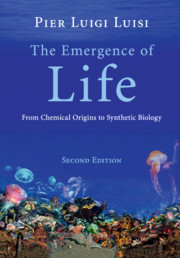Book contents
- Frontmatter
- Contents
- Acknowledgments
- Introduction
- Part I Approaches to the origin of life
- 1 Setting the stage
- 2 The hardware
- 3 Ascending the ramp of complexity
- 4 Experimental approaches to the origin of life
- 5 Origin of life from ground zero
- Part II What is life? The bio-logics of cellular life
- Part III Order and organization in biological systems
- Part IV The world of vesicles
- Part V Towards the synthetic biology of minimal cells
- As a way of conclusion
- Appendix The open questions about the origin of life
- References
- Names index
- Subject index
4 - Experimental approaches to the origin of life
from Part I - Approaches to the origin of life
Published online by Cambridge University Press: 05 September 2016
- Frontmatter
- Contents
- Acknowledgments
- Introduction
- Part I Approaches to the origin of life
- 1 Setting the stage
- 2 The hardware
- 3 Ascending the ramp of complexity
- 4 Experimental approaches to the origin of life
- 5 Origin of life from ground zero
- Part II What is life? The bio-logics of cellular life
- Part III Order and organization in biological systems
- Part IV The world of vesicles
- Part V Towards the synthetic biology of minimal cells
- As a way of conclusion
- Appendix The open questions about the origin of life
- References
- Names index
- Subject index
Summary
… l'uovo cadde dal ciel
e come a Dio piacque
l'uovo si ruppe
e la gallina nacque.
Introduction
This chapter is a review of the various proposals for the origin of life, limited to those approaches that have been or can be tested, in one way or another, by experiments. Therefore, I will not consider here the very many theoretical models, which have only a speculative, theoretical standing. This is certainly a shortcoming of this analysis, but on the other hand, the critical enumeration of all that has been proposed in the secondary literature on the subject (apparently, there are more than 30 models) would go beyond the space available in this book.
Rather arbitrarily, then, I will mention only a few of these approaches, beginning with the three most known: the prebiotic RNA world, the compartmentalistic approach, and the enzyme-free metabolism approach. A similar classification is made by Eschenmoser (Bolli et al., 1997a, 1997b).
We have examined in the previous chapter the chemical constraints to the understanding of the origin of life. They will be put in evidence in each of the various approaches to the origin of life.
The prebiotic RNA world
Walter Gilbert first used the expression “RNA World” in 1986, in a hypothesis for interpreting in a unitarian scheme the various properties of RNA, including catalysis (Gilbert, 1986). Apparently, this idea had been in the air before, for example, in Carl Woese's book The Genetic Code (1967), as well as in two papers by Francis Crick (1968) and Leslie Orgel (1968).
The basic idea is the primacy of RNA to originate all other biopolymers (proteins and DNA) and the main mechanisms up to the origin of life. The simplified scheme is shown in Equation 4.1, with the addition that the active form was a self-replicating RNA (sr-RNA), which in its replication would undergo mutation and corresponding production of catalytic RNA forms (ribozymes), which in turn would catalyze the formation of proteins and DNA.
- Type
- Chapter
- Information
- The Emergence of LifeFrom Chemical Origins to Synthetic Biology, pp. 72 - 96Publisher: Cambridge University PressPrint publication year: 2016



